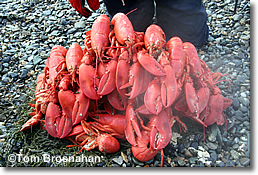The New England lobster (Homarus americanus) is a crustacean related to crabs, shrimp, crayfish and barnacles. An arthropod, it is more closely related to insects than to animals (hence the jocular term "bugs" for lobsters).
In colonial America, lobsters were so plentiful in New England's coastal waters that they were used as pig fodder. The prize catch back then was bland codfish.
Nearly 60 million pounds of lobster are caught in Maine, Massachusetts and Rhode Island each year. (In Canada's Atlantic provinces the catch is almost twice as large.)
Lobster Facts
Fresh from the water, live lobsters are green colored with dark splotches. They only turn red when cooked.
The two (of 10) front legs of the New England lobster have evolved to become large, powerful claws, which differentiate it from the Caribbean spiny lobster, which has no such front claws. When cooked, the claw meat is tender, sweet and delicious, and is looked upon as choicer than the tail meat, though that is also good.
How to Cook a Lobster
New England restaurants prepare lobsters in any number of elaborate ways (baked, stuffed, salads, etc.), but to a true New Englander there are but three ways to cook a lobster: you boil (or steam) it, you broil it, or you grill it.
Broil or Grill
To broil or grill, take a live lobster—no true New Englander would start with a dead one—and a big, sharp knife, make a straight cut underneath from head to tail, and place the lobster cut-upward under the broiler, or cut-downward on the grill.
Steaming
Boiling (really, steaming) is the most popular method, however, and is the easiest. Bring a few inches of seawater to boil in a big pot, drop in the live lobsters, cover the pot, bring the water to a boil again, and let the lobsters steam until they turn bright red (10 to 12 minutes, a few minutes longer for lobsters of several pounds or more).
When you take them out, the lobsters will be very hot and full of hot water, especially after moulting (see below). Give them a few minutes to cool so you don't burn your fingers or get scalded by boiling water when handling them.
Hard Shell or Soft?
The ease of eating a lobster depends partly upon the time of year. Lobsters moult (shed their shells) every year in early summer. Underneath the about-to-be-moulted shell, a new, roomier paper-thin shell is growing.
Just before moulting (May or June) a New England lobster's shell is thick and hard, and the claws difficult to break open. You will certainly need tools—maybe even a hammer!—to break the hardest claws.
(How do they wrestle their way out of those complicated, hard shells? Beats me...)
Just after moulting, the new shell is as thin as heavy paper, and the claws are easy to open without tools.
The new shells begin to harden within a few weeks after moulting, but an August lobster is still much easier to eat than a May lobster. As the year progresses, the lobster will grow into the larger shell and it will grow thicker...until next year's moulting.
However, because the new shell is much larger than the lobster (so it has room to grow into it), the empty space is filled with water—boiling-hot water if the lobster has just come from the cooking pot. Be careful eating lobster in August, September and October!
How to Eat a Lobster
Eating lobster is not a refined pastime. It should not be an exercise in etiquette. A picnic table with a newspaper cover to catch the shells is the perfect setting, a seaside lobster shack the best location.
However it is cooked, your lobster will be very hot and if it has been boiled or steamed (the most common cooking method), it may be full of hot water. Give it a few minutes to cool so you don't burn your fingers or get scalded by boiling water when handling it.
Utensils
Along with your hot, just-cooked lobster you'll be provided with these items:
— A lobster bib to protect your clothing from sprays of sea water, lobster juice and butter
— A claw cracker (like a nut cracker) to crack the claws so you can extract the claw meat—a delicacy.
— A small fork or "lobster pick"—a slender instrument for extracting meat from difficult, bony places
— A "bone dish" in which to deposit empty shells and picked-over parts.
Claws & Tail
Here we go: hold the body in one hand and the tail in the other, and break the tail off with a side-to-side motion. Holding the tail upside-down, stick a fork (upside-down) between the bottom of the shell (now facing upwards) and the tail meat and pull the whole chunk of tail meat out. The tail is the largest meaty portion of the lobster, but there's lots more.
Each claw should be broken and the meat taken out with the small fork or lobster pick, even from the joints that connect the claw to the body. This is the most delicious part, a real delicacy.
In larger lobsters ("selects," 1-1/2 pounds and over), you'll find tender little bites in other places too. Twist the four "flippers" off the end of the tail and chew out the delicate meat inside. Twist off each small leg: in the knuckle next to the body there's a nugget (use your lobster pick), and you can chew tender meat out of each segment in a leg.
Lobster Body
Diehard lobster-lovers (I'm one) go even farther. Tear the carapace (the hard body cover) off, split the body lengthwise, and behind where each leg was attached there's a morsel of meat.
Of the innards, the gray-colored liver (called "tomalley") is edible—chefs sometimes use it in sauces, though not everyone likes it. If you find a waxy red substance in your lobster, you have a female: it's roe (eggs), edible but not choice.
Messy, but Good!
By now you will have discovered that eating lobster is not a refined pastime. The image of the lobster as an item in haute cuisine is justified by its delicious flavor. But simple steamed lobster cannot be improved by even the most creative chef, and eating it should not be an exercise in etiquette.
A Lobster Glossary
Lobster Pot
A lobster trap sunk in the ocean with a rope and buoy attached to mark it and retrieve it. Lobster pots/traps used to be made of wood, with rope-net entrances for the lobsters: they could crawl in through the cone-like net, but not out.
These days most "pots" are rectangles made of plastic-covered metal mesh.
Chick or Chicken
A chick or chicken lobster is five to seven years old, weighing about one pound (450 grams) in its shell. It's prohibited to catch lobsters weighing much less than this.
Legal size is determined not by weight but by measurement of the carapace (from the rear of the eye socket to the rear of the main body shell).
A legal lobster must measure at least 3.25 inches (8.26 cm). A lobster smaller than this is called a short and must be returned to the sea.
Select
A select is a lobster weighing between 1.5 and 2 pounds (680 grams to 910 grams). These are the choicest because they make a good one-person portion. (Over half the weight of a lobster is shell, so a select gives you less than 1 pound/450 grams of meat.)
Jumbo
An unprecise term for a lobster substantially larger than a Select. Lobsters can live for more than a century and weigh as much as 44 pounds (20 kilos). Very large lobsters are often respected for their age and returned to the sea.
If you buy a large lobster, make sure you have a pot big enough to cook it in!
Cull
A lobster that's missing a claw. Claw meat is choice, so culls sell for less than lobsters with both claws.
Blue Lobster
Almost all New England lobsters are blue-green to green-brown when alive in the sea. They turn bright red when cooked. Lobsters of other colors are rare: a live blue lobster, its color caused by a genetic defect, is one in two million. A live red lobster is even rarer: one in 10 million, and a yellow or calico (mottled orange and black) lobster rarer still: one in 30 million.
Lobster - A Global History
Lobster - A Global History, by Elisabeth Townsend, is everyone's guide to the tasty crustaceans that are now considered a delicacy worldwide.

Once considered fit only to be used as fertilizer or fed to the poor and starving, lobster has long since assumed its rightful place as a favored main course on summer picnic tables, in sushi bars, and at elegant restaurants throughout the world.
New England has a special relationship with lobster, of course, but there's much more to this intriguing beast than devouring one or two at a summer lobster pound or clambake. Lobster has been around for at least 250 million years on earth, and has been found in 100 varieties.
—Lobsters were a favorite ingredient in still-life paintings by some of Europe's great masters
—Lobster precipitated an international conflict: the so-called "Lobster War" between France and Brazil (1963) over fishing grounds for lobster in the south Atlantic.
—Delicacy? Lobster is in the same phylum as the spider and the centipede. Basically, it's a bug!
—Lobsters are green when alive, red when cooked, yes? Not always. Some are blue!
There's lots more in Lobster - A Global History—more than the fascinating history. Besides the amusing and astonishing facts and the extensive information— and recipes— on its preparation, there are discussions of the humane treatment and killing of lobsters, and whether or not they feel pain.
Lobster? It's all here:
Lobster - A Global History, by Elisabeth Townsend. London: Reaktion Books Ltd, 2011. 144 pages, 40 color plates, 10 halftones. ISBN 978 1 86189 794 7, UK£9.99 RRP, US$15.95. Distributed in the USA by The University of Chicago Press.

